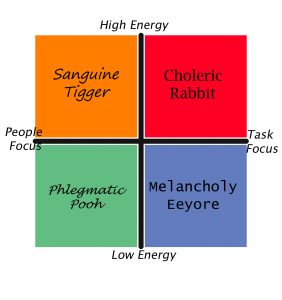Kids who try to run the household almost from birth have a unique gift of leadership.
The take-charge personality reminds me of Rabbit, from Winnie the Pooh stories. Rabbit shares the high energy top half of the Temperament Chart  with Tigger, but is over in the right hand corner, above Eeyore and on the task oriented side. Rabbit is a leader and likes to motivate others to get things done. He doesn’t get offended easily, especially as he gets more mature. Rabbit tends to be more self confident than the other temperaments and doesn’t worry too much about what others think of him. He is an active learner, curious and bright, grasping abstract concepts easily. Rabbits will speak up in class to answer other children’s questions because he can see quickly where the teacher’s explanation is confusing and he often has a better way. Although this is guaranteed to frustrate the teacher, Rabbit usually does do a very good job of understanding exactly what is being asked and clearly explaining the answer.
with Tigger, but is over in the right hand corner, above Eeyore and on the task oriented side. Rabbit is a leader and likes to motivate others to get things done. He doesn’t get offended easily, especially as he gets more mature. Rabbit tends to be more self confident than the other temperaments and doesn’t worry too much about what others think of him. He is an active learner, curious and bright, grasping abstract concepts easily. Rabbits will speak up in class to answer other children’s questions because he can see quickly where the teacher’s explanation is confusing and he often has a better way. Although this is guaranteed to frustrate the teacher, Rabbit usually does do a very good job of understanding exactly what is being asked and clearly explaining the answer.
Side note to parents: harness this tendancy and use it to let Rabbit teach what he’s learned to siblings. It’s a great way to test his comprehension of the material without resorting to tests.
Rabbit children like to get things done. Rabbit is a do-er. He will jump in, heedless of the dangers or consequences, accomplish the task and pick up the pieces later (or, more likely, move on to something else and forget about picking up). They are passionate, driven, goal orientated and energetic about projects, unlike Tigger, who is passionate and energetic about people. A visit to the Hundred Acre woods generally finds Rabbit hard at work, usually alone, on his next project. In their drive to accomplish, some rabbit children will bowl right over a more passive child, creating friction when those quieter children feel Rabbit is being bossy. And he probably is being bossy! He’s very good at knowing what needs to be done and he’s strongly motivated to make sure it gets done.
When a Rabbit temperament child is born into a family, look out! Life, and the balance of power in the house, is about to change. Right from the start, Rabbit wants to be in charge. He does not take orders from anyone and he is wired for domination. Remember the movie Willie Wonka and the Chocolate Factory? The little rich girl, Veruca, wanted to take home an Ooopa Loompa, and she wanted it NOW. That is an over-indulged Rabbit in action. Moms with quieter temperaments can be intimidated by the persuasiveness and confidence of a rabbit child and end up giving in to them rather than trying to come up with the energy required to out-maneuver them. Instead of trying to stop that energetic child, learn to harness and guide the energy toward productive areas.
This is probably a good place to remind you this description is of a strong, 100% Rabbit type temperament. Most children will be a blend of two temperaments with a little of a third thrown in. You will most likely find characteristics that fit your child in at least 2 of the descriptions. Add in environmental influences, being overtired or plain old emotional fluctuations and some days it may seem a child goes from one extreme to another, never fitting neatly into any description. This is particularly true for children under about 6 years of age. Before that age, much of their character is still forming and it is very difficult to pinpoint their temperament. It is still useful to understand the different temperament types. When a child is being extremely bossy for example, you will know it is leadership ability coming out inappropriately. Guide and direct those traits into their positive uses instead of trying to stamp them out as “character flaws”
Strengths
Leader
Bold
Decisive
Productive
Risk Taker
Independent
Self Motivated
Tenacious
Confidential
Resourceful
Competitive
Intelligent
Strong willed
Adventurous
Weaknesses
Bossy
Arrogant
Tactless
Intolerant
Stubborn
Impatient
Angers easily
Prideful
Workaholic
